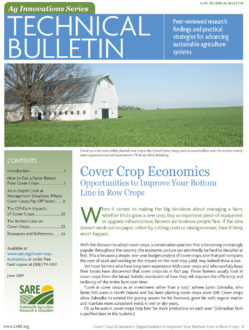The NRCS “cover crop economics tool” is a free downloadable spreadsheet that evaluates the cover crop payoff period based on the user’s data. Interpretative materials and supportive videos are also available through the NRCS website. Additionally, NRCS has an extensive series of soil health fact sheets and videos available through their website. Search “NRCS soil health.”
SARE Resources
SARE has multiple publications and online resources pertaining to cover crops, including:
The nonprofit Soil Health Institute offers a growing number of publications and videos pertaining to cover crops and soil health. See www.soilhealthinstitute.org.
References
- Basche, A. 2017. Turning soils into sponges: how farmers can fight floods and droughts. Union of Concerned Scientists.
- Bruggink, D. 2018. Cover crop train keeps rolling on. No-Till Farmer magazine blog: March 10, 2018.
- California Carbon Dashboard. 2018. Carbon price. Climate Policy Initiative.
- Congressional Research Service. 2018. Federal Crop Insurance: Program Overview for the 115th Congress. Library of Congress report R45193.
- Conservation Technology Information Center (CTIC). 2013–2017. Annual reports of the National Cover Crop Survey. Joint publication of CTIC and SARE.
- Filbert, M. 2017. Economic impact of grazing cover crops in cow-calf operations. Practical Farmers of Iowa: Ames, IA.
- Hanna, M., and M.M. Al-Kaisi. 2009. Understanding and managing soil compaction. Iowa State University Extension publication PM1901b.
- Hoorman, J., R. Islam, A. Sundermeier and R. Reeder. 2009. Using cover crops to convert to no-till. Ohio State University Extension guide SAG–11.
- Johnson, C. 2017. Cotton in cover. Furrow Magazine: October 30, 2017.
- Lal, R. 2014. Societal value of soil carbon. Journal of Soil Water Conservation 69(6): 186A–192A.
- Lazarus, W.F. 2018. Machinery cost estimates. University of Minnesota.
- Monast, M., L. Sands and A. Grafton. 2018. How stewardship generates value for farmers, lenders, insurers and landowners. Report of the Environmental Defense Fund.
- Sundermeier, A. and R. Reed. 2013. Tillage, cover crop, and compaction effects on corn and soybeans. Ohio State University research reports.
- Sunderlage, B. 2019. Presentation on cover crops and weeds at 2019 Midwest Cover Crop Council Annual Conference. Springfield, IL.
- Tang, C., G.E. Lade, D. Keiser, C. Kling, Y. Ji and Y. Shr. 2018. Economic benefits of nitrogen reductions in Iowa. Iowa State University Center for Agricultural and Rural Development.
- Tellatin, S. and R. Myers. 2018. Cover crop impacts on U.S. cropland carbon sequestration. Journal of Soil Water Conservation 73(5): 117A–121A.
- Tellatin, S. and R. Myers. 2018. Cover crops at work: Keeping nutrients out of waterways. USDA-SARE cover crop fact sheet series.
- Tellatin, S. and R. Myers. 2018. Cover crops at work: Cover the soil to prevent erosion. USDA-SARE cover crop fact sheet series.
- Wilcoxen, C.A., J.W. Walk and M.P. Ward. 2018. The use of cover crop fields by migratory and resident birds. Agriculture Ecosystems and Environment 252: 42–50.
